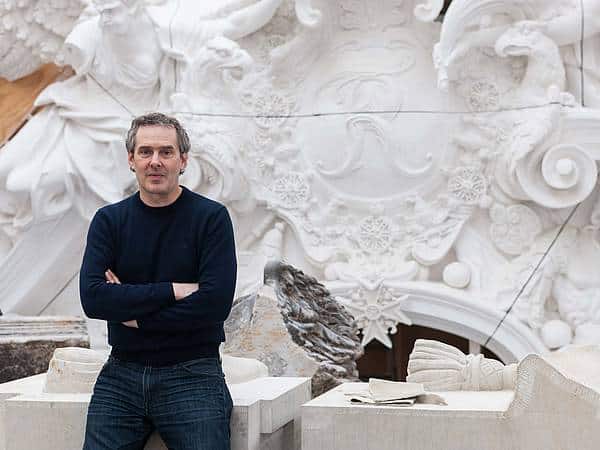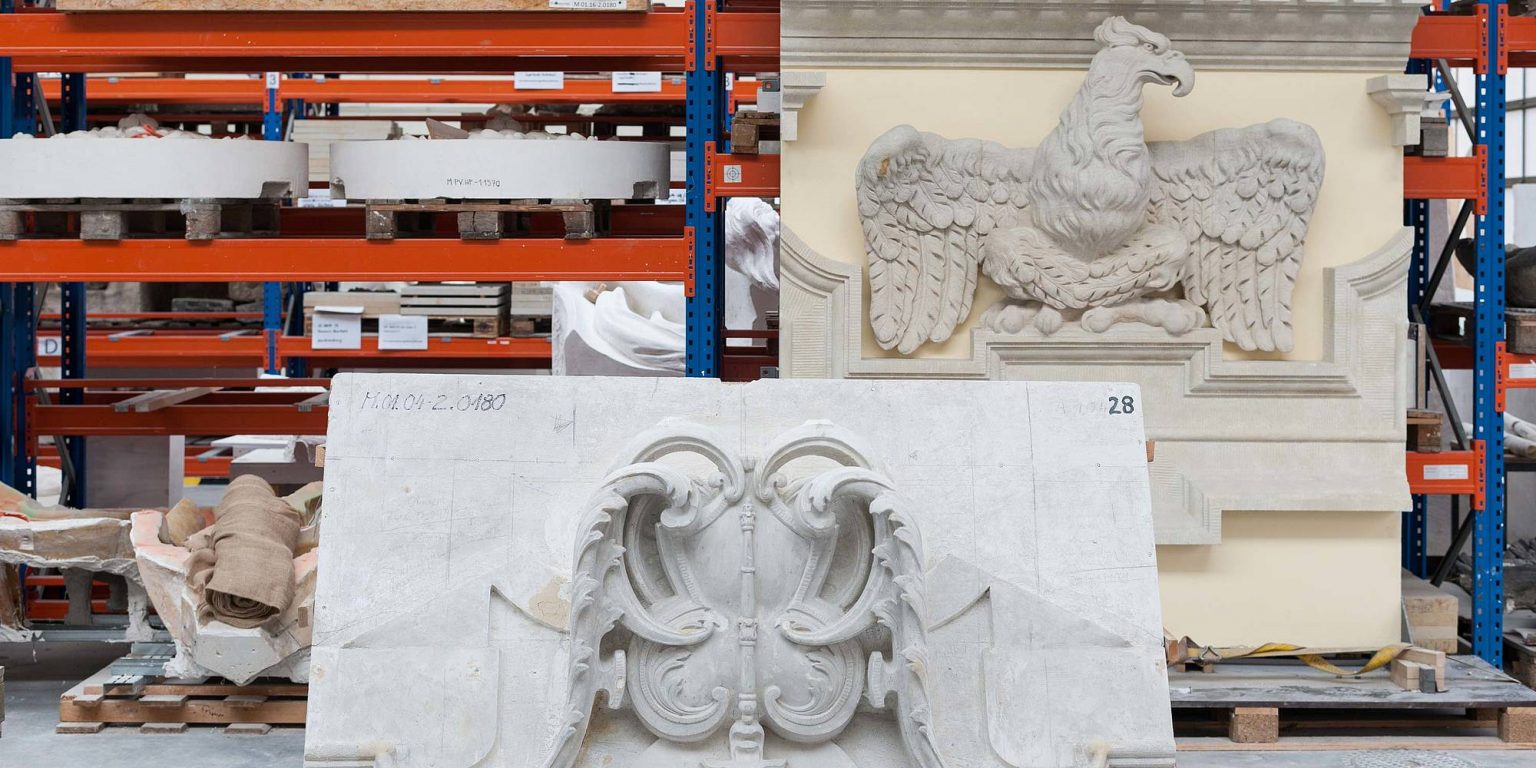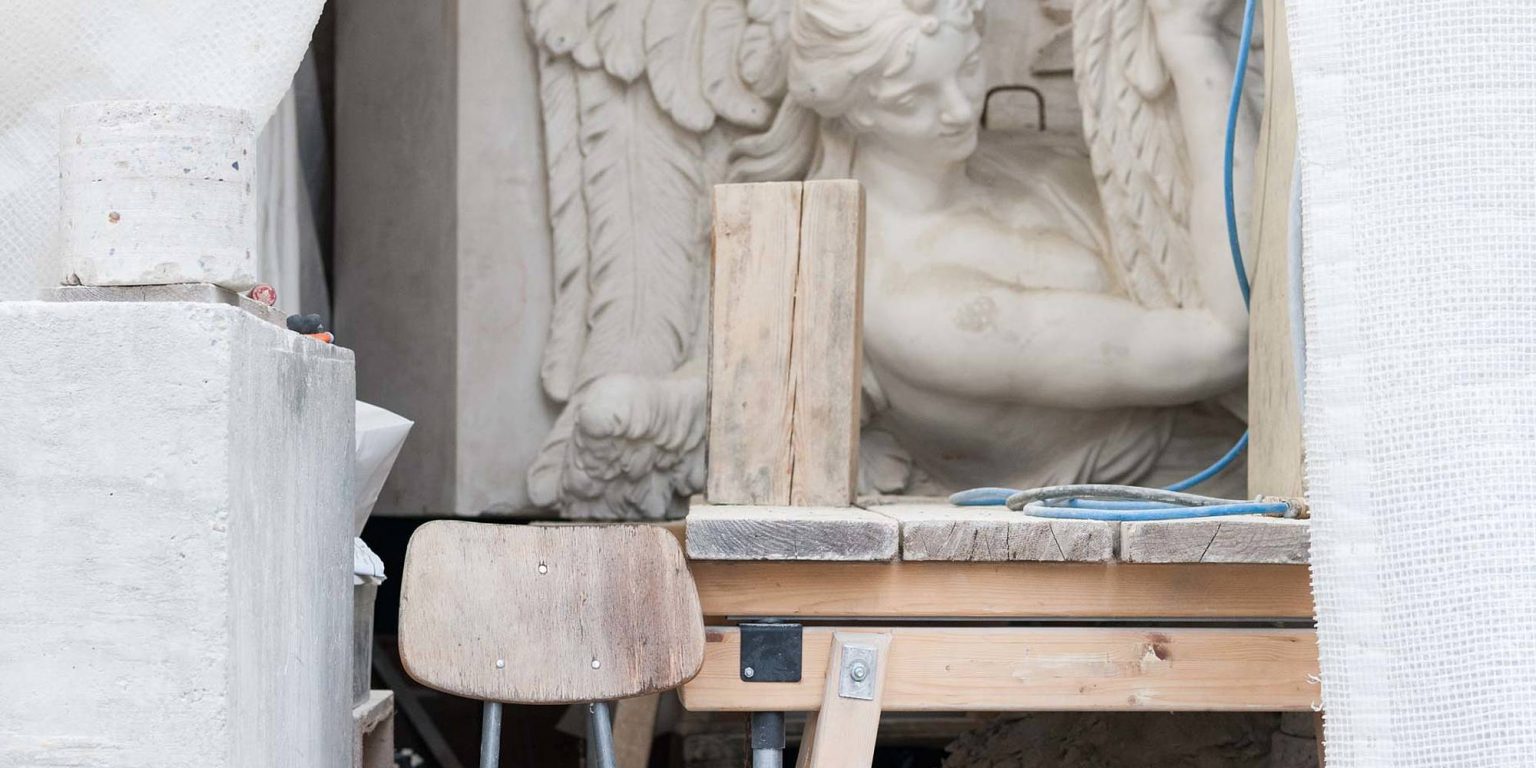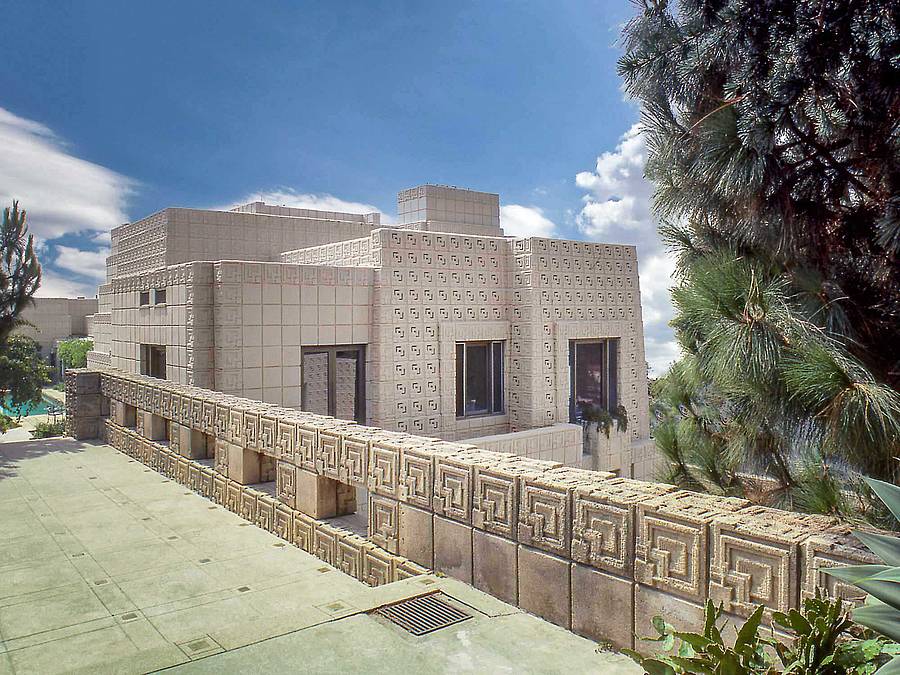
Stories
The big history puzzle
Eagles, lions, trumpeting angels and composite capitals – the Berlin palace workshop is home to countless figures and columns. Here, on the Askanierring in the Berlin district of Spandau, a mammoth project is underway…the reconstruction of the historic facade of the Berlin Stadtschloss. Keeping an overview seems almost impossible, but Berthold Just is doing just that. The 53-year-old manager of the palace workshop knows where each and every stone belongs and where every remaining historical fragment needs to go.

Almost 3,000 sculptures are being created from scratch for the project. This reconstruction is accompanied by a renaissance of an all but forgotten handicraft – stone carving…not to be confused with stonemasonry, as Just stresses. “All figures and floral, sculptural objects are made by the stone carvers, while stonemasons create architectural elements, such as columns,” he explained.
The process is made up of three steps. First, the stone carver creates a clay model. “This is easily a couple of tonnes of clay, which have to be kept moist and covered every day,” said Just. Every three weeks, the clay model is assessed by a commission of experts, including art historians and monument conservationists. Once it has been approved, the stone carver will create a silicon mould from the model. Using this, the master mould is then poured in plaster. However, the historical facade, like the original, is not made from plaster but rather from Saxon and Bohemian sandstone. A centuries-old method is used – copying using a pointing machine. The stone carver uses the machine to measure a point on the plaster model and transfers it to the sandstone, just like carvers in Ancient Greece and Rome would have done.

Each piece is created and approved separately
The stone carvers are also working outside the workshop on huge blocks of stone, the tools of their trade lined up next to them – cold and claw chisels, stonemason’s hammers with wooden handles and many more. Everything is covered with a fine layer of dust.
As this is a public construction project, each piece has to be created and approved separately. Apart from Berthold Just, nobody is actually employed at the palace workshop. The freelance carvers have to apply for each project anew. However, not all parts are made here. Tradespeople all across Germany are working on reconstructing the facade.
One of them is Andreas Hoferick. His workshop is in the Berlin district of Weißensee. As soon as you enter the courtyard, you can see the first figures. But only when you pull a plastic curtain to one side can you see the real action. Eight stone carvers from six nations are hard at work here.

Stone carving is like performing a piece of music
Andreas Hoferick and Berthold Just have known each other for many years. Both are master pupils of stone carver Jürgen Klimes, who is now 86 years old. The intense study of historical photos, film and remaining fragments has made them experts in their trade. “We’re trained in Prussian Baroque,” said Just. In the neighboring district of the future Humboldt Forum, he worked on reconstructions in the GDR, the armory, the Gendarmenmarkt or what is now the Museum for Communication.
Our work is not simply about making copies. It’s more about understanding masters such as Andreas Schlüter, Johann Friedrich Eosander von Göthe or Martin Heinrich Böhme. Part of that is knowing about antique laws of proportion or the use of feet as measurements. “You can compare stone carving with performing a piece of music. There are different interpretations but you keep to every note. When copying, you work with precision – but you have room to be creative when creating a clay model,” says Hoferick.
The German Parliament decided to reconstruct the Berlin Stadtschloss in 2002. Construction began in June of 2012, and the Humboldt Forum is set to move there by September 2019. The Parliament and the state of Berlin are footing the costs of the building’s construction. The money for the facade must be collected by the Berlin Schloss Association…that was a condition. The government will build the building, but the association is solely responsible for financing the facade. It’s supposed to cost approximately $115 million dollars. That’s a lot of money – but the fundraising campaign turned into probably the biggest crowdfunding appeal that there ever was. Projects of this magnitude are only really crowdfunded in the digital world – for new software or the development of a new gadget. But, this is something different. People are donating for the reconstruction of a historic facade for a castle once inhabited by the aristocratic Hohenzollern family.
A piece of castle for everyone
Some critics may dismiss it as nostalgia, but the association has collected approximately 63 million dollars in the last few years. “We are sure that we will reach our goal. The fundraising campaign is being received well, as is the project itself. We are working hand in hand with the developer, the Stiftung Humboldt-Forum im Berliner Schloss,” said Gritt Ockert, spokesperson for the association. The crowdfunding campaign was not just about money, but also about engaging people for a cause. Wilhelm von Boddien has been doing this for decades. He is the driving force behind the project. He was already drawing attention to the site in 1993 with a simulation of the Hohenzollern residence.
Today, everyone should be able to afford a piece of castle. The cheapest section costs 55 dollars, an eagle capital is as much as a small car, and a complete portal will set you back around 4.1 million dollars. Each donor knows exactly where the piece of the facade is that they financed. Each of them is listed in a log, from the class of 1955 in Kassel to companies, organizations and individuals all across Germany and the whole world.
In total, 11,772 cubic yards of sandstone are being built into the facade. The question is how are all these elements, adding up to several tons, secured? Just has the answer. “They are elaborately connected to each other by tensioned stainless steel. Andreas Schlüter used forged steel and iron.” Today, modern machines such as milling machines and scanners are used. Without them, the amount of time needed would be unmanageable – and costs would balloon.




